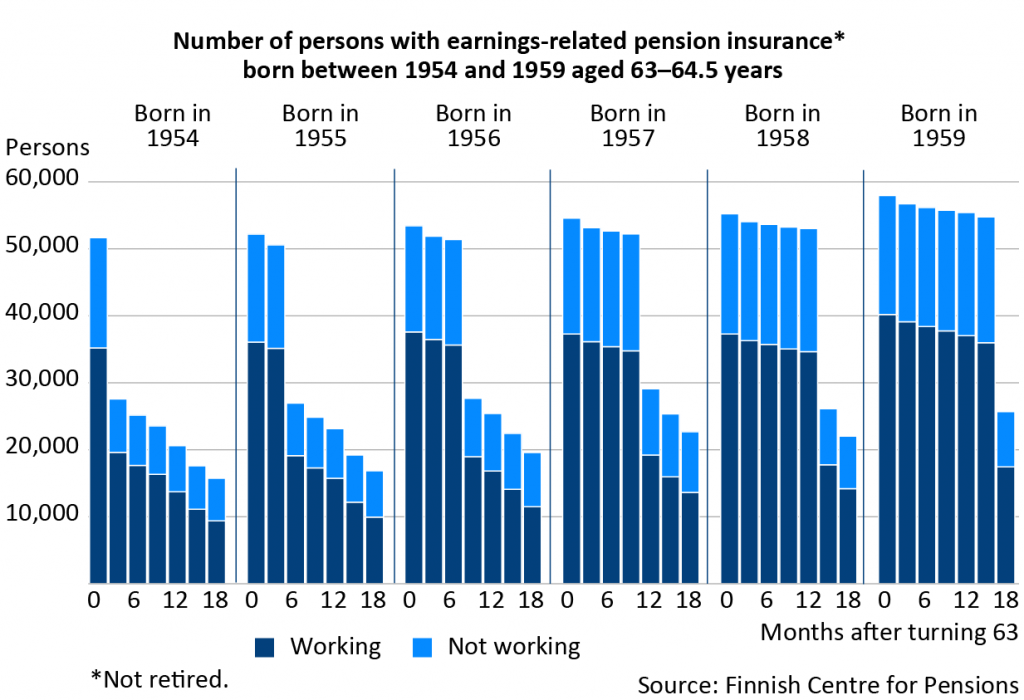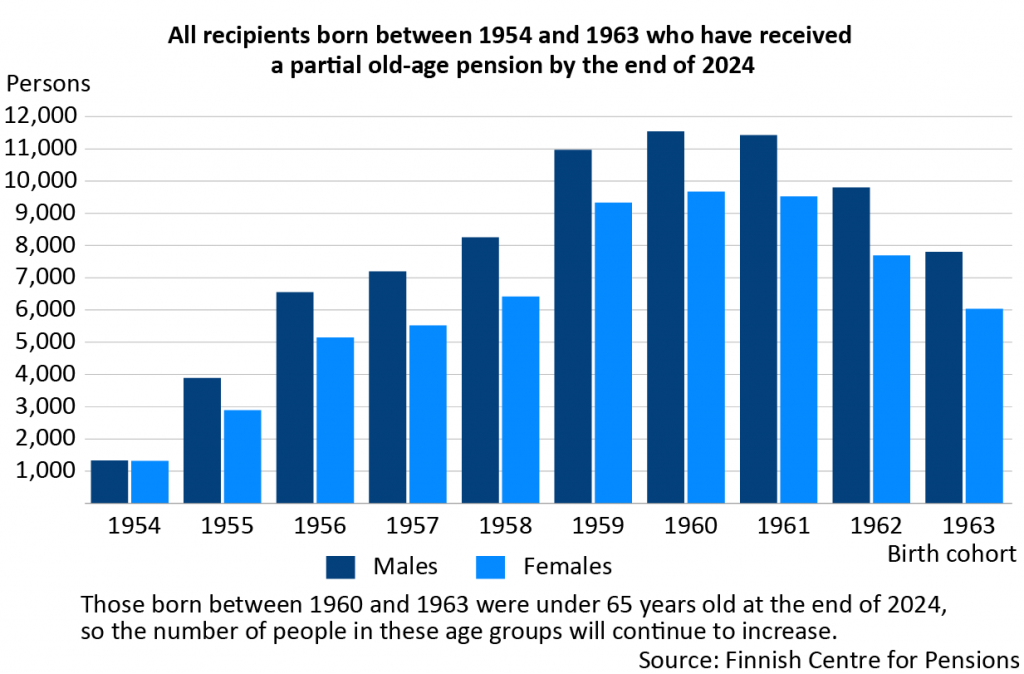New Pension Benefits and the Pension Reform 2017
The website New pension benefits and the pension reform shows how the 2017 pension reform affects the statistics . The pension reform introduced two new pension benefits: the partial old-age pension and the years-of-service pension. The reform also raises the retirement age gradually.
Increasing the retirement age for the old-age pension has delayed retirement and extended working lives

Raising the retirement age for the old-age pension appears to be working as intended. People are deferring retirement in line with the rising retirement age. As the proportion of insured persons in work has remained virtually unchanged up to the new retirement age, it appears that working after the age of 63 has increased considerably.
Those born in 1954 were the last age group to have a retirement age of 63. For younger age groups, the retirement age has risen and will continue to increase by three months for each age group, meaning that those born in 1962 have a retirement age of 65 years.
At the same time as retirement has been deferred, it has also become more common at the retirement age. A growing number of people are leaving the workforce as soon as they reach their retirement age. For those born in 1959, the retirement age is 64 years and 3 months. More than 40 per cent of insured persons in that age group left the workforce as soon as they reached that age.
The increase in the retirement age for the old-age pension has led to more people over 60 claiming disability benefits. However, the number of unemployed people close to retirement age has remained the same. It seems that the increase in the retirement age has not changed this situation.
(Updated on 9 October 2025)
More than 70,000 people received a partial old-age pension at the end of 2024

The number of people receiving a partial old-age pension rose steadily throughout 2024. At the end of the year, they numbered nearly 71,000, of whom 55 per cent were men.
In 2024, the number of new recipients of a partial old-age pension rose by 31,000, the second highest figure in the history of the statistics. This figure is only a few thousand lower than in 2022, when an exceptional index development encouraged many to claim the pension.
The popularity of the partial old-age pension has risen steadily in the different cohorts. Among those born between 1959 and 1961, almost one in three have opted for this benefit – more than 20,000 people in each cohort.
Among those born in 1963, almost 14,000 people, or 20 per cent, opted for a partial old-age pension in 2024. Of these, 11,400 opted for the 50-per-cent pension, which amounted to an average of 770 euro per month. As most pensions started immediately after the age of 61, the average period of early retirement was 47 months, resulting in an average reduction of 180 euros per month for the 50-per-cent pension in this age group.
Additional information:
(Updated on 13 May 2025)
Years-of-service pension paid to 206 people at the end of 2024
The old-age pension can be granted to persons born in or after 1955 who have worked for at least 38 years at a job requiring great mental or physical effort.
From 2018, people born in 1955 or later who have worked for at least 38 years at a job that requires great mental or physical effort have been eligible to receive the years-of-service pension.
The first years-of-service pensions were paid in 2018 and for a maximum of three months. As the pension can only be granted between the age of 63 and the retirement age for the old-age pension, a years-of-service pension starting in 2024 can be paid for a maximum of one year and nine months.
Over the past seven years, almost 2,000 people have claimed the years-of-service pension, of whom just over 600 have received it. Many claimants were directly granted disability or old-age pensions instead. Some claims have been rejected, often because the claimant did not meet the criteria for work requiring great mental or physical effort.
Years-of-service pension 2018–2024
| Years-of-service pension | 2018 | 2019 | 2020 | 2021 | 2022 | 2023 | 2024 |
|---|---|---|---|---|---|---|---|
| Claimants | 101 | 111 | 208 | 266 | 352 | 413 | 505 |
| Starting pensions | 21 | 27 | 72 | 84 | 119 | 134 | 162 |
| – Average pension €/month | 1,870 | 2,081 | 2,173 | 2,074 | 2,115 | 2,200 | 2,270 |
| Pensioners at 31 Dec. | 5 | 15 | 62 | 75 | 104 | 147 | 206 |
Additional information:
- News 13 May 2025: Number of partial old-age pension recipients in Finland doubled in a few years
- Years-of-service pension
Statistical services provides further information:
(Updated on 13 May 2025)